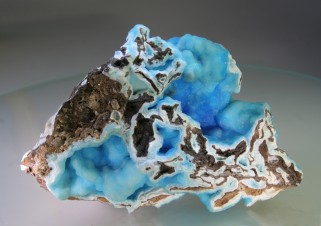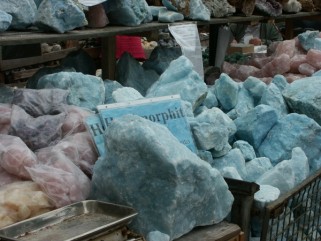Large quantities of blue or green Calcite / Aragonite, often with indication of origin China, are falsely offered as Hemimorphite or Smithsonite. A comparison of the chemical and physical properties shows the differences:
Hemimorphite

Fig.1: Natural Hemimorphite typically grown as crusty aggregates
Image: K. Sieber, www.makrogalerie.de
Genuine Hemimorphite is a relatively rare mineral. It forms in the oxidation zone of sulfidic lead-zinc deposits. On the basis of its physical and chemical properties Hemimorphite can be distinguished from its imitations without difficulty.
Chemical composition:
Hemimorphite is a water-bearing, alkaline zinc silicate with the chemical formula Zn4[(OH)2/Si2O7] · H2O. It does not react with acids unlike its most common imitations from the Calcite group. Dabbing it with 10% hydrochloric acid does not cause any gas bubbles.
Appearance:
Typical aggregates are grained, crusty, kidney-shaped, fibrous and radiating. Crystals which have different surfaces at one end than at the other end (called "Hemimorphie") are rare.
Color(s):
Hemimorphite usually occurs in white or brownish, rarely in light blue or pink colors.
Density: 3,30 - 3,50
Mohs hardness: 5
Calcite / Aragonite

Fig. 2: Calcite sold as blue "Hemimorphite" on a mineral fair.
Image: K. Sieber, www.makrogalerie.de
Light blue Calcite (trade name Aquablue) or Aragonite (trade name Perumar) and their composites can be distinguished easily from the similar looking Hemimorphite on the basis of their physical and chemical properties.
Chemical composition:
Both Calcite and Aragonite are calcium carbonates with the chemical formula CaCO3. They react with dilute acids, releasing CO2 gas bubbling up from the surface. This reaction is clearly visible as effervescence.
Appearance:
Mostly kidney-shaped, botryoidal aggregates as well as banded, radial stones. Calcite can also occur in crystals. In this shape it cannot be mistaken for Hemimorphite anymore.
Color(s):
Calcite and Aragonite mineral aggregates confusable with Hemimorphite are white, light blue (sometimes artificially colored), green or pink.
Density: 2,70 - 2,95
Mohs hardness:: 3 to 4
Conclusion:
By determining certain physical and chemical properties like density, hardness and chemical reactivity with acids, Hemimorphite and Calcite / Aragonite can be identified easily. We highly recommend to use these possibilities to distinguish genuine Hemimorphite from its imitations.
Smithsonite
The zinc carbonate Smithsonite appears on mineral fairs seldomly. From time to time larger amounts of this mineral were offered, with "China" given as origin. Gemmological testing revealed, that these light blue or blue green raw and tumble stones consisted of the calcium carbonates calcite and aragonite. To call this material "Smithsonite" is misleading.
X-ray spectroscopic examinations done by the EPI laboratory showed a maximum zinc content of 0.9 wt%. This low zinc content could be responsible for the blue green color. But with this low content of Zinc the stones cannot be called "Smithsonite" which by definition has to have at least 20 wt% of zinc.
Due to the large amount of imitated material on the market, it is very important and advisable to have Smithsonite checked for authenticity before buying it.
Autor: Dipl.-Min. B. Bruder
© INSTITUT FÜR EDELSTEIN PRÜFUNG (EPI)
Read more on this topic:




